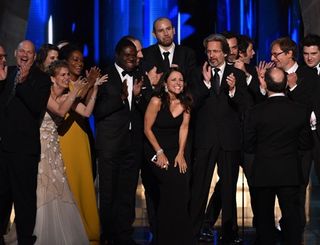The Evolution Will Be Televised

For a peek at what happens when audiences find entertainment options better suited to their evolving tastes, one need only to stroll down South Broadway in downtown Los Angeles, where the dinged-up marquees of shuttered movie houses—the Rialto, the Palace, the Roxie—belie their former grandeur. The theaters, a 15-minute walk from the Microsoft Theater that hosted the Emmys, served as a reminder for anyone in the programming business just how fickle audiences are in this cataclysmic digital age.
Broadcast chiefs speak frequently of their nets’ stranglehold on big-tent events. But while next year’s Super Bowl, with that fancy ‘50’ attached, will surely surpass the 114 million who watched last year, one wonders how much longer the Emmys can be considered a major TV event in the digital age. The reviews for Fox’s September 20 telecast showed that it was more than TV’s prom—Andy Samberg nailed his opener, the show chugged along at a good pace and, in a year fraught with racial tension, it showcased the raw emotion of African-American winners.
“For the first time in what seems like ever (though there have been intermittent good years), there wasn’t a lot of bloated nonsense and boring sections that dragged down the night and fueled Twitter hate,” wrote Tim Goodman in The Hollywood Reporter.
With just under 12 million viewers, down 24% from last year, it’s too bad America missed a good show. The Emmys were up against football, note the apologists, and too many niche shows were up for prizes.
But TV is, as the 2015 winners showed, a niche medium. Samberg’s Brooklyn Nine-Nine isn’t a hit even by modern standards on Fox, and cable once again treated the Emmys competition like its own Washington Generals—HBO leading with 14, followed by Comedy Central with four. Tellingly, Julia Louis- Dreyfus, star of way-offbeat Veep, thanked HBO for its “friendship” upon winning lead actress in a comedy. “Imagine that,” she added.
“The entertainment world has to face the facts,” said one prominent programmer. “TV has become a passion project.”
‘Net’ Present Value
Broadcasting & Cable Newsletter
The smarter way to stay on top of broadcasting and cable industry. Sign up below
But if broadcast networks are, by definition, big and broad, and premium cablers are niche and urbane, what about the streaming services? Amazon Instant Video got two Emmys for Transparent. Netflix only won one.
Netflix is alternately the migraine rattling around rival programmers’ skulls, the darling of Wall Street and the true killer app that Main Street consumers increasingly can’t live without. But its Emmy near-shutout may indicate a bigger problem facing networks— an unfocused brand in the competitive clutter. “Either you be a newer version of a broadcaster or you dive into the niche end of the business—you can’t be both,” said the veteran programmer. “Kids and horror and everything in between—I don’t think it’s a sustainable model.”
Betting big on auteur-types with big ideas that fit the brand, then giving them the freedom to execute them, is risky business, with the possibility of great reward. Programmers might be wise to borrow Samberg’s HBO Now password, then try to bottle some of its mojo.
Evolving the brand to keep up with capricious consumers is not only possible, but necessary. After all, some of those old L.A. movie houses have been rehabbed and now host weddings, conferences and rock ‘n’ roll shows; as one local conservancy site puts it, they are “ushering in a whole new era of entertainment.”
Those are words to live by for anyone in the content business.
Michael Malone, senior content producer at B+C/Multichannel News, covers network programming, including entertainment, news and sports on broadcast, cable and streaming; and local broadcast television. He hosts the podcasts Busted Pilot, about what’s new in television, and Series Business, a chat with the creator of a new program, and writes the column “The Watchman.” He joined B+C in 2005. His journalism has also appeared in The New York Times, The Philadelphia Inquirer, Playboy and New York magazine.

